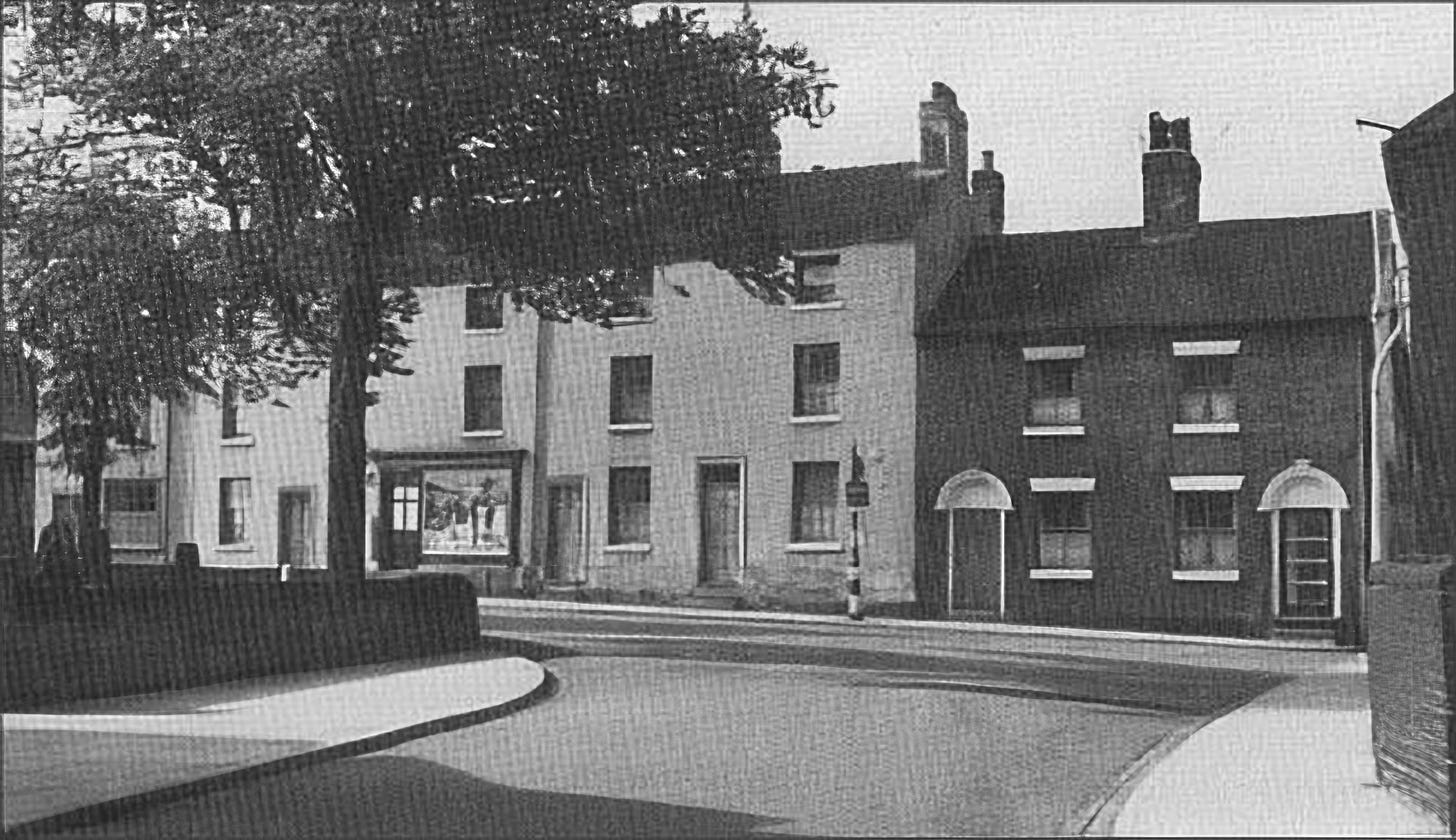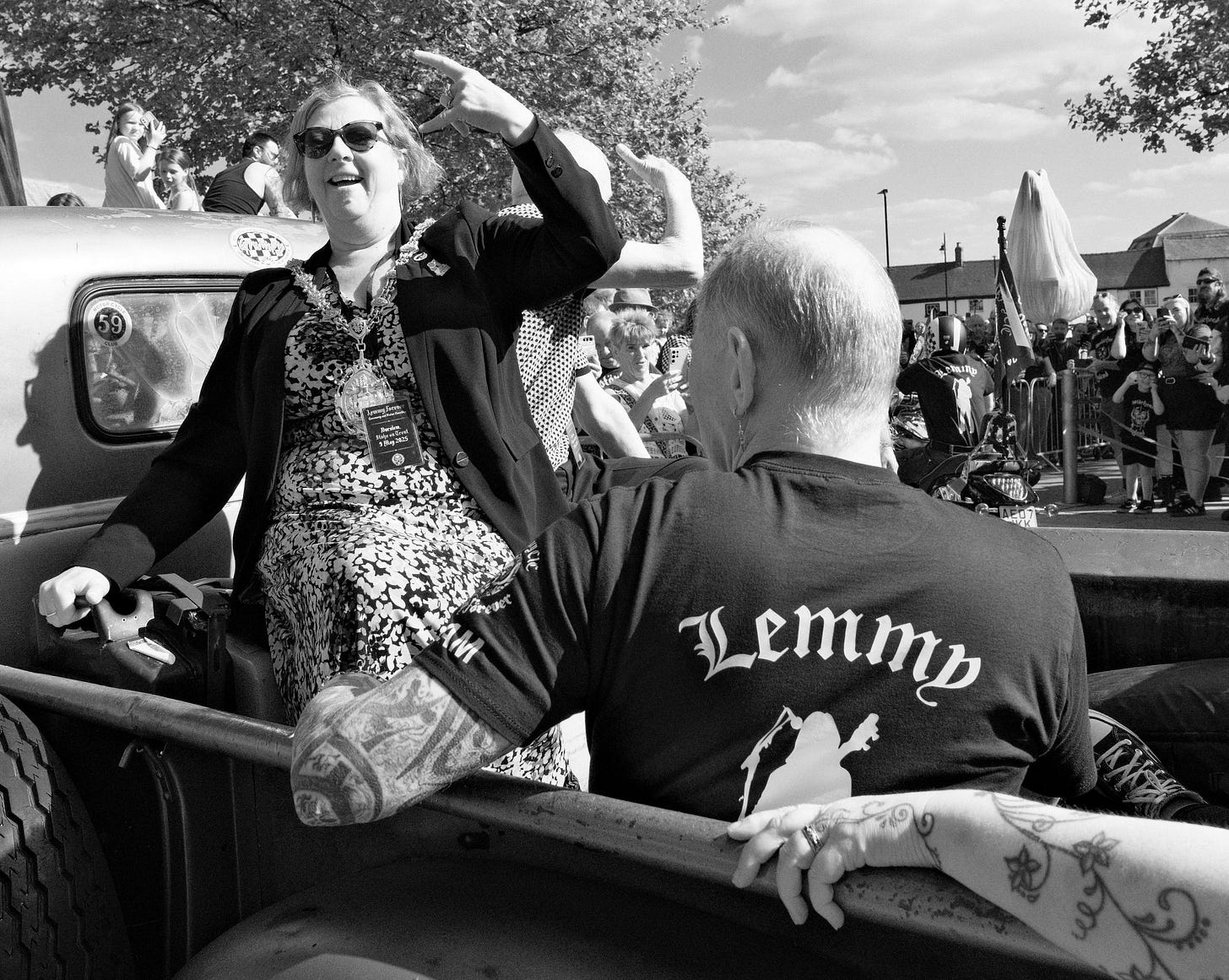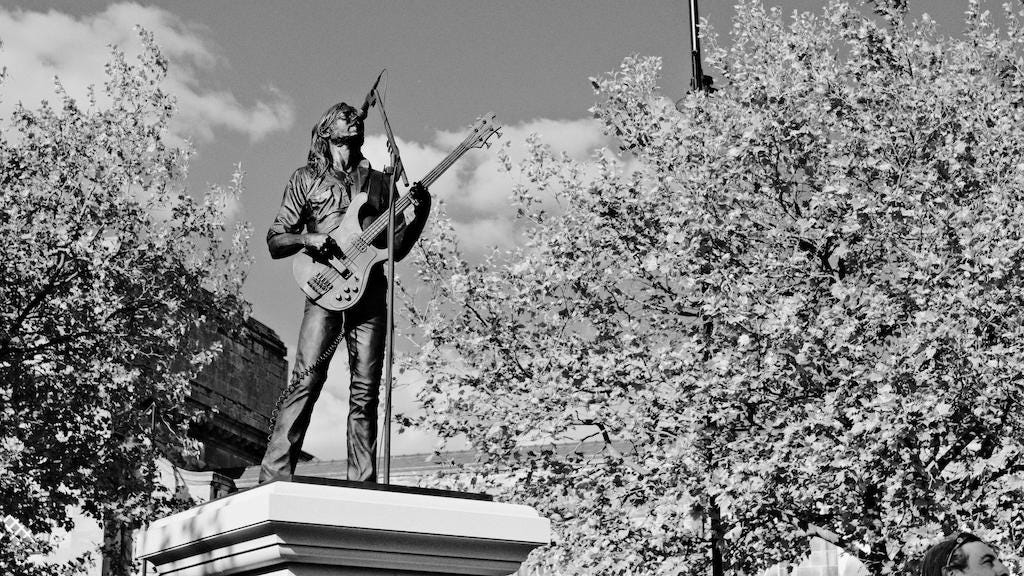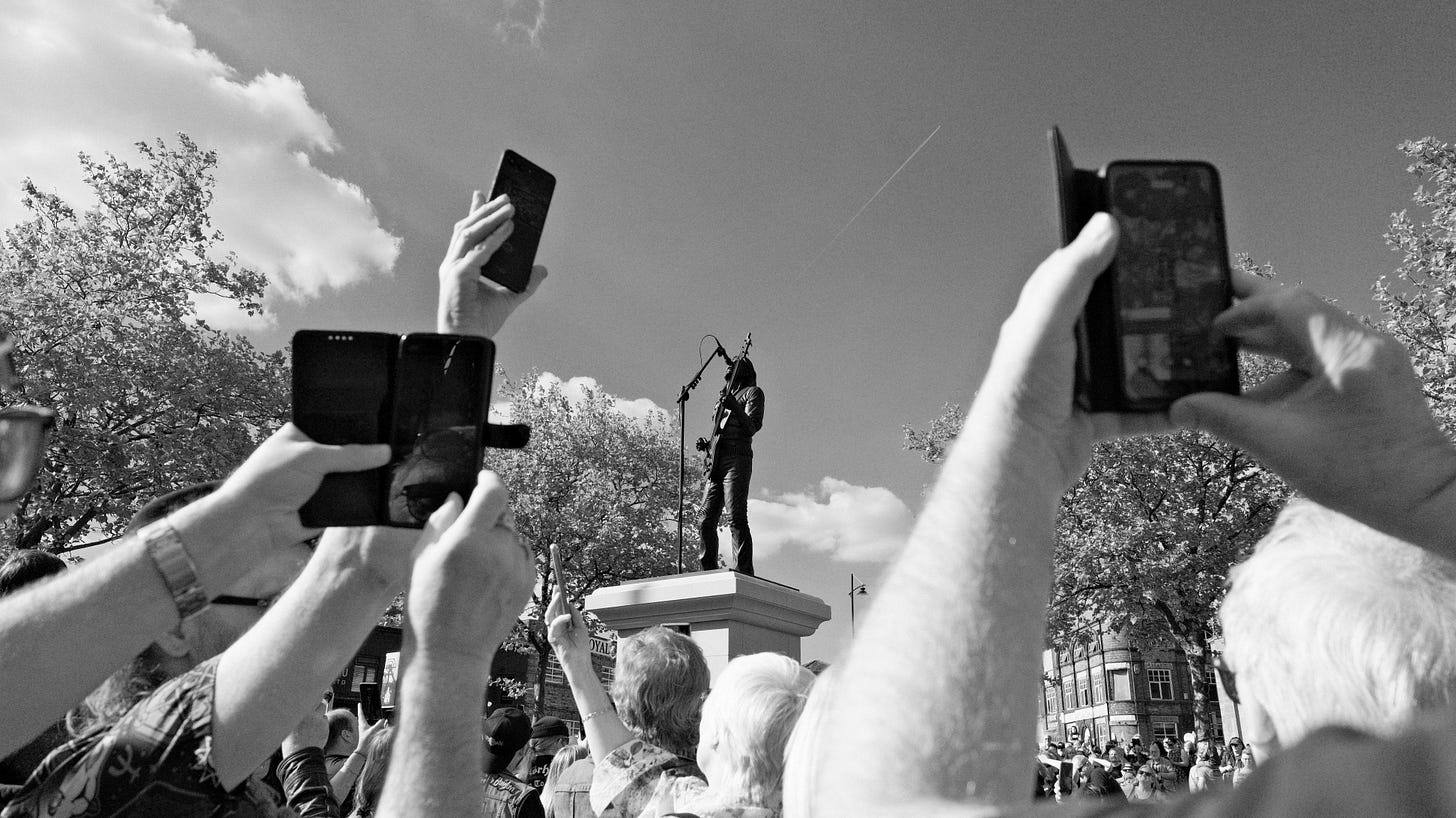Why Lemmy is to Stoke What Shakespeare is to Stratford-upon-Avon
Lemmy statue creator Andy Edwards argues Lemmy could supercharge Stoke’s tourism in the same way that Shakespeare draws visitors to his birthplace…
When trying to articulate the totemic importance of Lemmy, as we've memorialised him in his Burslem birthplace, I've sometimes reached for the shorthand: "He should be to Burslem what Shakespeare is to Stratford." It’s a comparison that spotlights the value of his name as a draw for visitors, and while most people understand the sentiment, it’s also led me to ponder if this is a silly thing to say or, in fact, a justifiable basis for a concerted effort. Why can't Lemmy's unique worldwide worship win the same status for Burslem and Stoke-on-Trent that Stratford-upon-Avon enjoys from being the birthplace of a figure who has become elevated to be an emblem of Britain.
Thinking about this present discrepancy has made me look at how many parallels there are between these two Midlanders. Though separated by four centuries, a closer look at the careers, attitudes, and cultural impact of William Shakespeare and Ian “Lemmy” Kilmister reveals a surprising number of shared qualities. Both men are defined by their approach to realism. They are writers who consigned a hard, heavy truth in their work, delivering insights into human nature with a shared penetratingly loud clarity. This is plainly notable despite self-elected cultural arbiters’ historical use of "highbrow" and "lowbrow" labels as a propagandistic tool to diminish the status and achievement of artists who don't fit neatly into their predetermined categories as is too often the case with artists working in rock, punk, metal and hip hop culture.
“They are writers who consigned a hard, heavy truth in their work, delivering insights into human nature with a shared penetratingly loud clarity”
At the heart of both Lemmy and Shakespeare’s enduring appeal to their enthusiasts and fans lies in that unflinching honesty about the human condition. Shakespeare's tragedies, romances, and comedies, for all their poetic grandeur, are filled with the messy, complex, and often ugly truths of life. From the bloody ambition of Macbeth to the jealous fury of Othello, he captures a world driven by base passions, greed, and the search for meaning in a chaotic world. His characters, whether kings or commoners, feel authentic because they are plagued by the same anxieties and desires that have gripped humanity forever. Similarly, Lemmy's lyrics are a chronicle of a different but equally authentic passage through another time and reality.
His words, delivered at high volume by gravelly roar, paint a vivid picture of life on the fringes: the endless struggle, the highs, lows and fleeting pleasures of the road, the political isolation and cynicism that result from it, and the irresistible, raw power of rebellion. A song like Ace of Spades is a perfect distillation of this ethos - a frenetic philosophical treatise on life's gamble, stripped of all pretence and delivered with the swagger of a nihilistic cowboy drifter grafter. Both writers, one with a quill and the other with a Rickenbacker, offer a mirror to their respective eras, showing humanity as it wretchedly and triumphantly is, not as it is more delicately dreamed as being.
The stark contrast in how society has categorised their individual work however is less a reflection of their content and more a commentary on the arbitrary nature of cultural hierarchies. Shakespeare's plays, originally performed for a diverse audience that included both royalty and common rabble, were once considered populist entertainment, full of bawdy jokes and sword fights. Over centuries, they have been elevated to the pinnacle of "high art," revered in academia and performed in hallowed places. This process has often sanitised his work, glossing over its more visceral and immediate elements to fit a narrative of refinement inflated with lavish spectacle. George Bernard Shaw mocked the cult of Shakespeare worship as "bardolatry”.
Lemmy's work, on the other hand, is an anchor of “lowbrow” culture. Like him it is loud, unapologetic, and inextricably linked to a subculture that actively rejects mainstream societal norms. Yet, this “lowbrow” label is a disingenuous tool used to control and dismiss. Lemmy's lyrics, with their themes of fate, justice, and facing the consequences of one’s actions, are as universal as Shakespeare's. The difference is merely in the packaging. One is presented with iambic pentameter, the other with a wall of Marshall amplifiers. Both were masters of their chosen medium, using their words and performance of them to convey powerful, relatable truths to an audience hungry for them.
“Statues can be like a kind of satellite dish, broadcasting and receiving the spirit of their subject, a repository for shared feelings”
Statues, if they're any good, as well as simply geographical and historical markers can be like a kind of satellite dish, broadcasting and receiving the spirit of their subject, a kind of repository for shared feelings. To echo and celebrate the performance aspect of Shakepeare’s legacy, his bronze monument in Stratford uses statues of four of his characters: Prince Hal, Lady Macbeth, Hamlet, and Falstaff to conjure it, around a figure of the playwright in the middle. In Lemmy’s hometown it is the crowd of visitors and regular gatherings and live performances in the plaza that are called upon to respond to their electrified hero presented on a stage above them to evoke the energy and feeling that are such a vital part of Lemmy’s legacy. It is this ever present invitation of a beacon like lone figure high above a former empty square that marks out the concerted effort still required to raise Lemmy and Burslem to the status and number of visitors that Shakespeare’s Stratford enjoys.
Over 400 years, Shakespeare has become a worldwide best-seller, with the numbers for his plays and poetry sold believed to be in excess of four billion copies. Over that period, the ubiquity of the book served to build popularity, understanding and status, unchallenged by any other means of conveyance. The modern day has seen a decline in reading that was noted and understood by Lemmy before the explosion of social media and streaming. “People don't read any more. It’s a sad state of affairs. Reading's the only thing that allows you to use your imagination. When you watch films it’s someone else's vision,” he said.

Despite living her early life in a former Victorian workhouse in Penkhull, the very oldest part of Stoke on Trent, young Ian Kilmister’s Mother Jessie was a librarian, accounting for her son’s lifelong voracious appetite for books. In modern measures of appeal, if you take the recorded figure of over 41 million album sales by Lemmy and Motörhead, their unrelenting performances on the road, broadcasts on TV, streaming and plays on the radio, the achievement of a 50-year career are pretty remarkable to the figures for near half a millennia that Shakespeare’s success is measured.
It’s true that the future is changing so scarily fast that huge numbers of city dwellers retreat to their superfast broadband and ready meal holes for security as soon as they finish work, scurrying indoors before the sun’s gone down these days. But in 12 short weeks since the Lemmy hometown statue was unveiled to more than 3,000 people on a Friday afternoon, the memorial is rarely alone. Visitors come and pay their tributes and hang around to talk to others daily, travelling from over 25 different countries already recorded in the visitors’ book. The second live event, Encore, on 3 August featured art exhibitions, a vintage car and bike show, four bands playing in the newly nicknamed Lemmy Plaza and live acts performing across five venues in the town all in celebration of their rock n roll son. This all testifies to a resurgence, new confidence and surviving appetite among people to enjoy each other’s company in a safe public space, watched over by a figure who stood for a free independent lifestyle and loved nothing more than good people enjoying good times.
“Imagine the town with a fully functioning Queens Theatre, reborn as Kilmister Halls, a live venue with a music school and recording facility”
After a celebrated career in London, when Shakespeare returned to live in Stratford, he could buy the second most expensive house there. In contrast, Lemmy chose to rent a small crummy apartment within walking distance of his favourite haunt, The Rainbow Bar & Grill on Sunset Strip, because he felt most at home among his friends, both old and new. This simple fact speaks volumes about his priorities and how we might best build his legacy in Burslem – by making it live, spontaneous, free and busy with people, gatherings and performances all the time. If anyone saw the sea of purple roses waved by the crowd and the little lad holding drumsticks given to him by the drummer of Monkey Wrench, the headline band, as local singer and sometime busker Joel Ramble stepped onto the stage to close out the day and perform an impromptu and the most emotional version of Mama, I’m Coming Home written by Lemmy for his mate Ozzy, then they’ll appreciate that you can’t write these things down, you have to be there.
Imagine the town with a fully functioning Queens Theatre, reborn as Kilmister Halls music school, recording facility, state of the art live venue, museum, with its own Rainbow Bar and Grill, hosting the very best talent anywhere alongside our own local people and entertaining visitors from more countries still than the 25 already signed in from around the world and them all feeling like it’s a welcoming home from home. Is that a silly idea or something that’s happening right in front of you, right now?
Lemmy’s birthplace in Stoke on Trent, like Shakespeare’s in Stratford is more than just a geographical marker; Burslem is a like a nurturing, healing, rejuvenating, wellspring. We should revere and celebrate this place. It’s not what’s passed, it’s what’s next. Lemmy Forever.
About the author, Andy Edwards
Since his first major commission of The Stanley Matthews triple statue in 2001, Blurton-born Andy has created more than 50 notable public works including The 1914 Christmas Truce monument in Flanders, statues of The Beatles on Liverpool’s waterfront (plus Bob Marley and Muhammad Ali in the same city) and The Bee Gees statue on the Isle of Man, with works presented to and unveiled by President Barrack Obama, The Prince and Princess of Wales, Pelé, Archbishop Desmond Tutu and others. Check out his website here and don’t miss, too, his TedTalk at the University of Staffordshire (he graduated from the uni with a first-class honours degree in Design and Applied Arts in 1986). For more on Lemmy's legacy in Stoke, go here.












I visited from Lancashire Lemmy's statue to pay my lifetime respects, as I had travelled a long way I need to use the pay toilet close by which was not working so I had to go and find one.
This took me away from the place that I wanted to be to and left me feeling a little let down.
If the council & my home town want people to come and visit our area then a least get the basics right as news travels fast & these people won't come at all.